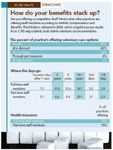Sweeten the deal
Make sure your benefits stack up well against the other options team members could find in your area-and give employees more reasons to stick around.
So you're feeling like you place a classified ad in the "help wanted" section every week. And just about the time you think that last hire is finally going to make it, she takes off.
If these frustrations ring a bell, step back and look at your team compensation and benefits package. Do you offer a sweet enough deal?
I consulted with a practice about a year ago that offered excellent medicine and surgery and had a very competent practice manager. But the practice constantly suffered from high staff turnover. The churn affected their profitability, customer service, and team morale.
We took a hard look at employee compensation and benefits and made some changes. Some cost quite a bit; others not as much. But over the past year, the team significantly reduced turnover and improved profitability. You've heard you'll spend at least half an employee's annual salary to recruit and train a replacement. So it's easy to see why it's better to talk good people into staying. These strategies can help.
Provide more paid vacation
This is an easy one to tackle. Most veterinary practices offer five days of vacation to their team members after one or two years of employment and 10 days per year after three or more years. Some even offer 15 days of vacation after seven or more years of employment.

Why team members stick around
Why not offer additional vacation days, or make them available sooner? If you're not already, you might offer one week of vacation after a year of employment—or even after six months with the practice. Then give two weeks after team members' second year of employment—and maybe add a day per year until they get up to three weeks of vacation. Exceeding the standard certainly makes the job more attractive and may help you retain some key employees.
Offer personal leave
I've never been a big fan of sick time. In my opinion, it rewards employees for being sick or encourages them to lie to use up their sick days. I prefer personal leave instead. Many practices offer full-time employees a half day per month or six days per year of personal leave. Employees use it if they're ill or for any reason, with a manager's approval at least 30 days in advance. Normally this time can accumulate to six or 12 days so it acts like a short-term disability policy.
To enrich this benefit, why not offer six hours per month instead of four? Or, forget all sense of reality and offer one day per month, or twelve days a year. You could also reward employees who don't use their personal leave by offering to double the days they have left at the end of the year and pay or give them a bonus for them.
Of course, if you increase employees' vacation time and personal leave, you might not have anyone actually at the practice to work, and you'll still have a sizable payroll—so remember to be practical. But still, a little improvement here and there will make quite a big difference.
Offer personal time off
Instead of setting aside specific days for vacation and sick time or personal leave, some practices choose to offer a block of personal time off (PTO). Employees can use this time for vacation, sick time, or personal leave. You might offer a full-time employee 90 hours of PTO after his or her first year, 115 hours after year two, and 130 or 150 hours after year three.

How do your benefits stack up?
I know a practice that used a combination of vacation and PTO. They maintained their vacation policy and on top of it gave employees 60 hours of PTO after a year of employment. Employees really appreciated the flexibility this offers.
Celebrate a few more holidays
Most practices offer their full-time employees six paid holidays during the year: New Year's Day, Memorial Day, Fourth of July, Labor Day, Thanksgiving Day, and Christmas (or the Jewish New Year). Why not enhance this benefit? For example, I like to add the employee's birthday to this list.
Ideally you have stellar employees and you want them to know you think they're "10s." So why not give them their birthdays off? Not only will they appreciate it, but just think of all that downtime you avoid when they're not celebrating their birthdays at work—cakes, cards, presents ... taking them out to lunch. Give them the day off! It will enhance your productivity. (OK, maybe the productivity thing is a stretch. But it's still a good idea.)
There's nothing to stop you from giving your full-time employees other paid holidays off, too. If you're closed for Martin Luther King Jr. Day, Christmas, or New Year's Eve, you might consider adding these holidays as employee benefits.
Offer health insurance
Personal health insurance ranks as one of the most-sought-after benefits. True, this is also one of the more expensive employee benefits. Still, many practices cover all or some percentage of their employees' health insurance premiums.
If you're paying a percentage of the premium, consider increasing that percentage. If you cap this payment, consider raising the cap. If you're not paying the entire premium and can afford to, maybe you should.
You do need to be careful here, because insurance costs will continue to increase. So shop for your policies. And I suggest setting a cap for what the practice will pay. You might increase the cap in the future, but at least you'll have some protection from escalating costs. Of course, if you're not offering health insurance, this is a great benefit to add.
Think through pet healthcare benefits
Most practices offer some type of veterinary healthcare benefit, but that's pretty much where the similarity ends. Some offer 50 percent off medical and surgical costs. Some include products, others don't. Some limit this benefit to one, two, or three personally owned pets—others don't. And some cover employee-owned pets fully, while, again, others don't.
You can enhance this benefit easily. If you pay a percentage, you might increase it. If you limit the number of personally owned pets, you can increase the number of pets covered.
Another idea: Provide a stipend depending on team members' tenure with the practice. For example, employees might have a $100 credit placed on their account after a year of employment, $200 after two years, and so on until they get to five years, at which time they'd receive a $500 credit yearly.
This "money" can be used toward their pets' medical and surgical needs, and even products purchased. Any additional costs incurred by employees for their pets could be provided at a discount. It's a great benefit—and one that encourages and rewards longevity. (See "Benefits by the Book" under Web Exclusives at www.vetecon.com for the tax rules that apply to offering team members credit for veterinary care.)
Purchasing an insurance policy for employees' pets is another popular option. Any and all services can be provided at no cost to the employee, but the practice receives some reimbursement from the insurance company.
As an added benefit, the employee sees firsthand how pet insurance works, which arms them to talk to clients about this option. You could choose to cover additional pets depending on the employee's tenure. (See "Benefits Made Easier" under Web Exclusives at www.vetecon.com for tax information and added benefits of offering employees pet insurance.)
Invite pets into the workplace
Sixty-six percent of respondents to a survey of 150 people by www.dogster.com and the job search engine Simply Hired indicated that they would work longer hours if they could bring their dog to work. And 32 percent would take a 5 percent pay cut for the benefit. It may not work for every practice but it's certainly worth consideration.
If you have limited space, how about offering this benefit as a reward for longevity? Once an employee has worked for you for two or three years, he or she can bring a pet to work. I know a practice team that rotates days among its employees. Each day one team member is scheduled to bring a pet to work. Maybe you could offer this reward to the "employee of the month." This benefit doesn't cost much. And it could certainly mean a lot to your team members.
Invest in retirement programs
Employees are becoming savvier regarding their personal financial planning. And we've all been warned not to depend on Social Security. Are you offering any type of retirement program for your healthcare team?
Many available plans require only a matching contribution of 3 percent by the employer—and only for those employees who actually contribute to the plan. Talk to your accountant or financial planner and see what strategies he or she recommends for your practice.
Clearly, this is not an exhaustive list of the benefits you could offer. And you may not be able to absorb the financial burden of improving right this minute. But again, think about the costs of replacing an employee. Then think about whether you've got room to improve.
Treat your team as a resource. Value their contributions. Offer the best benefits you can. And pay wages they can actually live on. If you do, you just might retain the clever, competent individuals who make good hospitals great—and improve your practice's profitability.
Editors' note: Do you feel like your benefits are affecting your employee longevity? Share your thoughts with colleagues at www.VetMedTeam.com.
The bottom line
If you're experiencing high employee turnover, you may not be offering competitive benefits. Look at these areas and make sure that you're offering a good deal.
- vacation days
- personal leave and personal time off
- paid holidays
- health insurance
- veterinary healthcare
- pets in the workplace, and
- retirement plans.
Hospital Management Editor Mark Opperman is a certified veterinary practice manager and owner of VMC Inc., a veterinary consulting firm based in Evergreen, Colo. He'll speak on assertive management styles, behavioral interviewing, and more Aug. 26 to 29 in Kansas City, Mo. For more, visit www.thecvc.com.

Mark Opperman